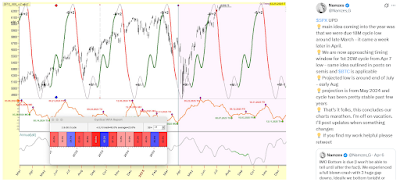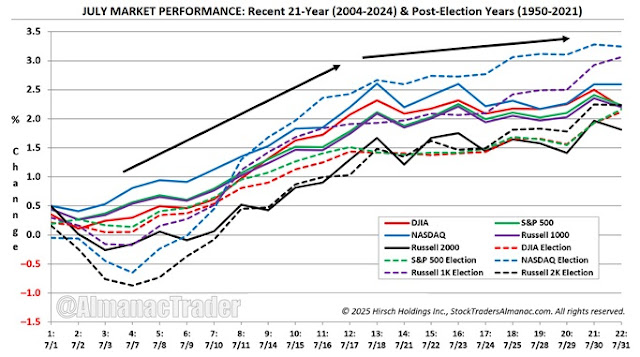Since 1990, the Friday of July’s monthly options expiration week has shown a bearish bias for the DJIA, which declined 21 times in 35 years, with two unchanged years—1991 and 1995. On that Friday, the average loss is 0.36% for the DJIA and 0.35% for the S&P 500.
Showing posts with label Presidential Cycle. Show all posts
Showing posts with label Presidential Cycle. Show all posts
Saturday, July 12, 2025
Seasonal Weakness in US Stocks During July Options Expirations | Jeff Hirsch
Labels:
4 Year Cycle,
Branimir Vojcic,
Data Mining,
Jeffrey A. Hirsch,
Namzes,
Post-Election Year Pattern,
Presidential Cycle,
S&P 500 Index,
Seasonality,
Steve Miller,
US-Stocks
Wednesday, June 25, 2025
July 2025 Post-Election Seasonal Pattern of US Stock Indices | Jeff Hirsch
July begins NASDAQ’s worst four months but is also the seventh best performing NASDAQ month since 1971, posting a 0.9% average gain. Lively trading often accompanies the first full month of summer as the beginning of the second half of the year tends to bring an inflow of new capital.
Typical Post-Election Year July: Early Strength, Beyond Mid-Month Mixed.
Reference:
Jeffrey A. Hirsch (June 25, 2025) - Typical July Trading: Strength Early, Beyond Mid-Month Mixed.
Jeffrey A. Hirsch (June 25, 2025) - Typical July Trading: Strength Early, Beyond Mid-Month Mixed.
Data
from the Stock Trader’s Almanac are showing that since 1950, July has
been the strongest month for both the DJIA and the S&P 500 in post-election years.
Specifically, the DJIA has averaged a 2.1% gain, ranking first among
months, with 15 positive years and only 3 negative years. The S&P
500 mirrors this, averaging a 2.2% gain, also ranking first, with 12
positive and 6 negative years.
This covers 19 presidential election
cycles from 1952 to 2020, providing a robust dataset spanning post-war
booms, recessions, and technological shifts. A
notable statistic is the 10-year streak of positive July returns for
both indices from 2015 to 2024, suggesting a recent intensification of
this seasonal pattern. The table below summarizes the performance:
Post-Election Years with 1st-Term Democrats +14%, 1st-Term Republicans +1%.
See also:
Labels:
4 Year Cycle,
Jeffrey A. Hirsch,
Post-Election Year Pattern,
Presidential Cycle,
S&P 500 Index,
Seasonality,
US-Stocks
Monday, June 2, 2025
June 2025 Post-Election Seasonal Pattern of US Stock Indices | Jeff Hirsch
In post-election years since 1950, early June strength has been notably stronger for NASDAQ and Russell 2000, while DJIA and S&P 500 have typically struggled.
Typical June Pattern of the S&P 500 in a Post-Election Year:
Early Strength: Starts with a slight uptrend, weaker than NASDAQ (2.5%) or Russell 2000.
Mid-Month Dip: Drops around days 10-15 due to profit-taking or uncertainty.
Late-Month Recovery: Rallies late June to a neutral or positive close, less than small-cap/tech gains.
So
far in June 2025, Russell 2000 ($IWM) has gained 3.8% and NASDAQ ($QQQ)
2.5%, setting the stage for a typical brisk mid-month drop followed by a
month-end rally, often led by technology and small caps.
Labels:
4 Year Cycle,
Jeffrey A. Hirsch,
Post-Election Year Pattern,
Presidential Cycle,
S&P 500 Index,
Seasonality,
US-Stocks
Tuesday, April 1, 2025
April 2025 Seasonal Pattern of US Stock Indices | Jeff Hirsch
The
first half of April used to outperform the second half, but since 1994
that has no longer been the case. The effect of April 15 Tax Deadline
appears to be diminished with bullish days present throughout April.
Traders and investors appear to be more focused on first quarter
earnings and guidance throughout the entire month of April.
As you can see in the above chart of the recent 21-year market performance in April and post-election years since 1950, April has historically been nearly perfect with gains steadily building from the first trading day to the last with only the occasional and minor blip along the way. In post-election years, April does tend to open on the soft side, but the early dip has historically been shallow and brief.
Since 1950, April has shown steady market gains from the first trading day to the last, with occasional
minor dips. In post-election years, April starts weaker, but the dip is brief and shallow.
As you can see in the above chart of the recent 21-year market performance in April and post-election years since 1950, April has historically been nearly perfect with gains steadily building from the first trading day to the last with only the occasional and minor blip along the way. In post-election years, April does tend to open on the soft side, but the early dip has historically been shallow and brief.
In post-election years, April remains a top performing month ranking second best for DJIA and S&P 500, and third best for NASDAQ. Average gains since 1950 for DJIA and S&P 500 are comparable to all years, but notably improve for NASDAQ, Russell 1000 and Russell 2000. NASDAQ’s three post-election year April declines were in 1973, 1993 and 2005.
Reference:
Jeffrey A. Hirsch (March 27, 2025) - Taxes Schmaxes – April Strong Open to Close – Deadline Impact Fades.
Jeffrey A. Hirsch (March 25, 2025) - April is the second-best month for S&P 500 and DJIA.
Other Bullish Scenarios:
Post-Election Years with 1st-Term Democrats +14%, 1st-Term Republicans +1%.
Average move higher: +4.78% (during 18 out of 20 years, up = 90%).
Potential opportunity shorting the S&P 500 in
the next major downturn over the coming weeks.
the next major downturn over the coming weeks.
See also:
Labels:
4 Year Cycle,
Jeffrey A. Hirsch,
Post-Election Year Pattern,
Presidential Cycle,
S&P 500 Index,
Seasonality,
US-Stocks
Saturday, March 1, 2025
March 2025 Seasonal Pattern of US Stock Indices | Jeff Hirsch
Rather
turbulent in recent years, with wild fluctuations and large gains and
losses, March has been experiencing some significant end-of-quarter
hits. In post-election years since 1950, March has tended to open
strongly, and this strength has generally persisted until shortly after
mid-month (as indicated by the dashed arrow below). At that point, the
major indexes lost momentum and closed out March with some choppy
trading. In contrast, over the past 21 years, March has trended lower
through mid-month before rallying in the second half.
March strong early-month, mid-month losses with choppy trading,
often rally after Quadruple Witching (March 21), likely sharp decline the week after.
often rally after Quadruple Witching (March 21), likely sharp decline the week after.
March is a particularly busy month. It marks the end of the first quarter, which brings with it quarterly Quadruple Witching (Friday, March 21) and an abundance of portfolio maneuvers from Wall Street. In recent years, March Quad-Witching Weeks have been quite bullish, but the week after has been nearly the exact opposite, with the DJIA down 22 of the last 37 years—and often down sharply.
See also:
Labels:
4 Year Cycle,
Jeffrey A. Hirsch,
Post-Election Year Pattern,
Presidential Cycle,
S&P 500 Index,
Seasonality,
US-Stocks
Tuesday, February 4, 2025
The Most Consistent Seasonal Patterns in the S&P 500 | With Statistics
Excluding the specifics of the decennial and presidential cycles, the average annual cycle of the S&P 500 since 2004 reveals five consistent seasonal periods, three of which are suitable for high-probability swing trades (90%+):
Since the S&P rises 70% of the
time, bearish trends are less consistent than bullish ones.
The average annual performance of this seasonal strategy was +18.91%.
# 1: Mid-February to Late-March Decline: Price action shows an important top between February 14 and 15, followed by a bearish trend lasting into March 20.
Bearish from February 14-15 High to March 20 Low (2004-2023).
Average move lower: -2.35% (during 12 out of 20 years, down = 60%).
[ ¡ stats in tab referring to February 15 to March 1 (not March 20) - typo, error ?]
Bullish from March 23 Low to April 27 High (2004-2023).
Average move higher: +4.78% (during 18 out of 20 years, up = 90%).
# 3: July Rally: Since 2009, the S&P 500 has always risen between June 27 and July 25. Not most years. Every single year.
Bullish from June 27 Low to July 25 High (2009-2023).
Average move higher: +4.27% (during 15 out of 15 years, up = 100%).
# 4: September Chop: Lack of clear bullish or bearish trends; tentatively sideways to down.
September chop between September 1 High to September 30 Low (2009-2023).
Average move higher: +2.77%. Average move lower: -2.63% (during 8 out of 15 years, down = 53%).
# 5: November Rally: S&P 500 consistently rising since 2004 and averaging a 4.88% gain.
Bullish from October 25 Low to November 30 High (2004-2023)
Average move higher: +4.88% (during 18 out of 20 years, up = 90%).
Labels:
Annual Cycle,
BeSomebodyFX,
Decennial Cycle,
Decennial Pattern,
EquityClock.com,
Fund Flows,
Jeffrey A. Hirsch,
Presidential Cycle,
Robert Miner,
S&P 500,
Scott Rubner,
Seasonality,
Swing Trading,
US-Stocks
Wednesday, January 8, 2025
S&P 500 Post-Election Year Patterns by Political Party | Robert Miner
Since 1949, the typical pattern of a Post-Election Year is generally flat until late March. The second and
fourth quarters are notably bullish, while the first and third quarters
tend to be less so. A significant correction in the third quarter is usually followed by a bull trend into year-end. Since 1981, the average trend in Post-Election Years has followed a similar structure but with consistently higher returns (average performance of all Post-Election Years since 1949 +8%, since 1981 +15%).
Post-Election Years with 1st-Term Democrats +14%, 1st-Term Republicans +1%.
That said, Post-Election Year returns have historically favored 1st-Term Democrats. Since 1949, there has been only one instance of a loss during a Post-Election Year with a 1st-Term Democrat, while 4 out of 6 1st-Term Republicans saw losses.
Market Action in Post-Election Years under Republicans and Democrats since 1953.
— Jeffrey A. Hirsch, January 14, 2025.
— Jeffrey A. Hirsch, January 14, 2025.
Data suggests caution in the third quarter during a 1st-Term Republican administration, and the first quarter is typically the worst-performing. Swing traders should wait for the Spring Low to occur between late March and early April before entering long positions. Post-Election Years generally show strong second-quarter performance with a consistent bull trend from the Spring Low to the Summer High (which can occur as early as mid-May), with an average return of around 4%. The Summer High period, from June to August, sees positive returns only in about one-third of Post-Election Years.
Labels:
4 Year Cycle,
Business Cycle,
Kitchin Cycle,
Position Trading,
Post-Election Year,
Presidential Cycle,
Robert Miner,
S&P 500,
Seasonality,
Swing Trading,
US-Stocks
Subscribe to:
Posts (Atom)

























.PNG)




















%20Seasonality%20(2000-2025).png)




